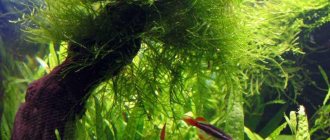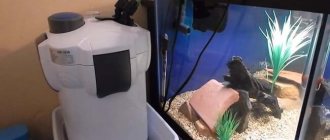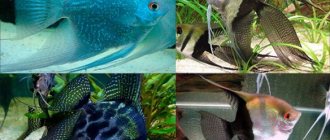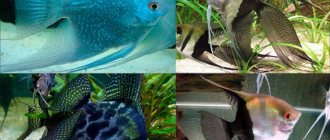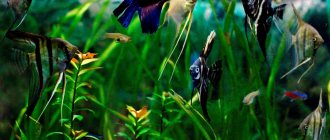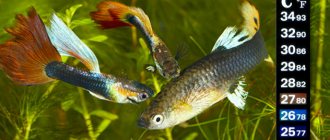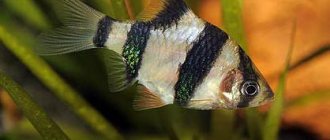Description of the species
The fish have a rounded body that is compressed at the sides. Sometimes they take on a disc-shaped body. The body is greater in height than in length. The ventral fins are elongated in the form of threads, the fins in the area of the back and anus are large and quite long. The pectoral and caudal fins are cone-shaped.
Length – no more than 15 cm, height – about 25 cm.
Body color varies: from all shades of green to all shades of gray, often a mixed range. The scales are small, barely noticeable.
By gender, the differences lie in a denser body and a convex forehead in males.
In the wild, angelfish live in the basins of the Amazon, Orinoco, and Essequibo rivers. They prefer habitats with slow currents and dense vegetation.
Angelfish care and maintenance
Minimum aquarium volume
For a comfortable existence, a large living space is necessary, as these cichlids love to swim. Therefore, its volume should be no less than 100 liters, and its height should be no less than 50 cm. The width does not matter, since angelfish can be found in narrow aquariums and maneuver among decor and other fish due to the narrow structure of their body.
The volume of the aquarium is directly proportional to the number of angelfish in it, so if you want to add another individual to it, you will need to increase the total volume of the aquarium by 30 liters.
Water
The water should be within 25 - 28º C; lowering or exceeding this temperature range can lead to illness and death of fish. The water in the aquarium must certainly be soft, Ph level - from 6.4 to 7.0, hardness - 1-15°.
It is necessary to clean the bottom of the aquarium and update the water in it weekly. It is not recommended to completely drain the water. Angelfish do not tolerate changes in climatic conditions well, so you only need to drain a third of the aquarium and bring it to the original level with new water.
Angelfish are housed in groups, this gives them the opportunity to look for a partner for subsequent reproduction.
These fish do not tolerate sunlight well, so vegetation with large leaves should be present to create shade. Vallisneria is ideal as algae - they both create shade and do not disturb the fish.
Feeding and diet
This type of aquarium fish is unpretentious in nutrition. They eat almost any live food: bloodworms, daphnia, tadpole. Due to the high risk of infection of angelfish with live food (due to the presence of pathogens), they should be fed frozen food, which is first thawed and brought to room temperature.
The food source for fish can be:
- chopped ground beef or seafood by-products;
- specialized dry vet food. store;
- algae, duckweed.
The fish should be fed 2-3 times a day, in small portions so as not to overfeed them. Overfeeding leads to bloating and death of the fish.
Maintenance and care
When breeding angelfish, care and maintenance must be properly organized so that the fish feel good. They need a spacious aquarium, but its height should not be more than 50 cm. In addition, it must have dense vegetation. The water temperature should be 24-28 degrees. However, they can easily tolerate temperatures of 18 degrees, although not for long.
It is worth mentioning separately about feeding. It is better to underfeed the angelfish a little rather than overfeed it. It is recommended for fish to fast once every 3 months. Experts advise feeding angelfish 1-2 times a day. They prefer live food and can also nibble on algae.
Compatible with each other
Which fish do angelfish get along with in an aquarium , and which do not, should be judged by the characteristics of a particular genus of fish. In principle, this is a very peaceful breed, and can live in the same aquarium with almost everyone. Cichlids are a voracious genus of fish; the only proximity that is contraindicated for them is fry. The latter simply will not survive in such a neighborhood; they will be completely absorbed.
Angelfish can be aggressive during the spawning period, so proximity to smaller fish is also contraindicated for them.
Individuals of the same species are well compatible with each other, especially if they grew together. If the fish begin to behave aggressively, it is necessary to temporarily remove the newcomer to the school.
Angelfish: compatibility with other fish
Keeping angelfish is permissible in a general aquarium , but we must remember that they are cichlids that are partial to small fish, fry and crustaceans. Take this factor into account when planning the arrangement and settlement of the aquarium - this will help to avoid innocent victims of other inhabitants.
It is allowed to keep cichlids with medium and large species, although they coexist well with neons. They definitely won’t like being next to all types of barbs. In one day, a flock of small Sumatran barbs can eat all the fins of angelfish. Viviparous fish - swordtails, mollies, congo, guppies, moonfish - will become good neighbors.
Who are they compatible with?
Ideal neighbors for them are: swordtail, thorn, catfish, gourami, parrot, lalius, apistogramma.
Guppies, neon, discus and goldfish are not the best neighbors.
Can an angelfish live alone in an aquarium?
This type of fish is a gregarious fish, so it is not recommended to keep the angelfish alone for a long time, it will die.
Soma Corydoras
These are almost perfect neighbors. They have a calm and measured character. Catfish and angelfish practically do not notice each other and do not physically intersect. Angelfish swim in schools in the upper layers of the aquarium, while catfish rest on the bottom.
Gourami
They have a phlegmatic type of temperament and are non-conflict. Minor aggression can only occur when there is a direct collision of bodies between gouras and angelfish.
Botsiya
They have a bright striped color and belong to the loach family. They mainly live at the bottom in driftwood and stones. The two types of fish do not interfere with each other at all.
Mollies
Sometimes mollies can gnaw off the fins of angelfish, but in general, their compatibility is ideal.
Pecilia
Absolutely devoid of aggression and very peaceful.
Catfish plecostomus
They have a friendly disposition, are slow, and lie mostly on the bottom.
Rainbows
If you raise both species together from the age of fry, they are quite compatible. Sometimes an adult rainbowfish, due to its color, can become bait for an angelfish. Therefore, the aquarium must be designed in such a way that the iris has the opportunity to hide in case of danger.
Rasbory
Due to their small size, they can sometimes be perceived by angelfish as food. But in general, they are compatible.
Labeo
They live mostly alone. If there are many of them, competition for territory develops between them and the angelfish. Conflicts and injuries may arise.
Tetras
They are so harmless that they do not arouse any interest in angelfish in principle.
Aquarium with angelfish
Angelfish are very unusual fish; they are very graceful, distinguished by an outlandish crescent-shaped body and highly elongated fins. Because of their unusual nature, they are called “angelfish” in Western countries. Due to their uniqueness, angelfish are very popular among aquarists; they have a calm disposition and get along quite peacefully with other fish.
At the moment, three main types of angelfish are known:
- The common angelfish (Pterophyllum scarale) is a silvery fish with 4 stripes.
- The Altum angelfish (Pterophyllum altum) is a fish with an elongated body and wide fins.
- Leopold's angelfish (Pterophyllum leopoldi) is a small fish with a large black spot.
Contents of angelfish
Angelfish are territorial fish of a fairly large size, which means that to keep them you need a fairly capacious aquarium, so two adult fish should have at least 100 liters of water. The height of the aquarium is also important; it must be at least 50 cm, and the top of the aquarium must be equipped with a lid to prevent the fish from jumping out.
Let's take a closer look at the basic requirements for keeping angelfish in an aquarium.
- Water. In natural conditions, rivers such as the Amazon and Orinoco are home to angelfish. These are rivers of the tropics and the water in them is warm, soft and acidic, so the water in the aquarium should have the following parameters:
- Temperature in the range of 24-28°C
- Acidity 6.5-7.5
- Hardness 5-15
The water must always be clean, which means a water filtration system and a compressor are necessary, and in the case of keeping expensive Altum angelfish, installing a UV sterilizer will also be relevant. To maintain a comfortable temperature, install a thermostat.
- Priming. For angelfish, it is necessary to use small pebbles or coarse quartz sand, because this kind of soil will closely match the natural one. In addition, living plants take root well in such soil, and angelfish, whose habit is to “rest on the bottom,” will not damage their delicate fins. In decor, preference should be given to a natural style; fish will look very advantageous among natural stones and driftwood.
- Vegetation. A must-have decorative element. Firstly, it will fit perfectly into compositions of stones and driftwood, which, like vegetation, are placed along the walls of the aquarium. Secondly, the plants will create zones of illumination so that the fish can hide from bright light if they wish.
Aquarium neighbors for angelfish
As mentioned earlier, angelfish are friendly, however, there are some nuances here too. Thus, it is not recommended to add larger fish to the aquarium, since the angelfish will at least be left without fins or may even die. It is not advisable to add too small fish to the aquarium, because angelfish are predators one way or another.
Medium-sized fish will be ideal neighbors, but in the case of a neighbor, it is worth considering the “interior” of the aquarium, namely, creating shelters for smaller neighbors, which will protect them from attack. Stones and grottoes, branchy driftwood or ceramic decor, as well as thickets of living vegetation are perfect for this. Excellent neighbors for angelfish will be fish such as Mollies, Swordtail, Gourami, Lyalius, Antistrus and others.
Relatively compatible species
Compatibility of angelfish with other fish is only under certain conditions.
Barbs
If the barb is the only representative of its kind in the aquarium, it will show aggression towards angelfish, not finding its own kind. It can bite off scales and fins.
Danio
Another thing that angelfish get along with in an aquarium is zebrafish. They are very calm and peaceful. However, there is a risk of angelfish hunting them at night.
Swordtails
They behave aggressively towards angelfish. Staying together is possible only when growing from fry.
Neons
Neons swim in the lower layers of the aquarium, angelfish in the upper layers. However, the former often become the prey of the latter.
Ternetia
They eat the same food, but the thorns are smaller in body size and they often become food for the angelfish themselves.
Acne
Quite aggressive. They should only be kept with large fish.
Shrimp and crab
Shrimp and crabs also get along with angelfish. However, the latter are predators and can sometimes attack angelfish.
Incompatible fish
Types of fish that absolutely cannot be kept in the same aquarium with angelfish:
African and South American cichlids
They have a fighting character and start conflicts and fights. They take food.
Discus
Predatory breed. They can only live within their own species.
Goldfish
Angelfish and goldfish are not compatible. They have different habitats, goldfish love cool water, dig up soil, and muddy the water.
Cockerels
Other species that do not get along with angelfish are bettas.
The bright color of the cockerels triggers the hunting instinct of the angelfish.
Guppy
Angelfish should not be kept with guppies. The latter provoke the former to aggression and easily become their prey.
Koi carp
Large size. Angelfish become live food for them.
Astronotuses
Very voracious and aggressive towards any type of fish.
Breeding angelfish
In a community aquarium, angelfish reproduce naturally. Artificial propagation consists of several stages:
- Definition of par. Females are smaller than males, their body is somewhat chopped, the front fins are single, and the genitals are blunt in shape. Males are large, with a fatty mound on the forehead, double fins and a pointed genital organ.
Preparing for spawning
If there are no males in the aquarium, the male does not develop reproductive products.
The temperature in the aquarium should be increased by 3 degrees, regularly change 10% of the water from the total volume of the aquarium, at least 4 times a week.
Angelfish lay their eggs on a hard surface, so you need to place a block, cone, plate, or broad-leaved plant in the aquarium.
After choosing a laying territory, the pair begins to aggressively defend its area. The female develops a convex abdomen. These signs indicate readiness for spawning.
Angelfish spawning and spawning
Occurs when the fish turn one year old. Natural pairing occurs. The male is courting the female. The formed union is strong and durable. After the pair is formed, the next stage begins.
Spawning process
Occurs more often in the afternoon. The female, pressing against the surface, lays eggs, the male, repeating her movements, firmly attaches the droppings to the surface.
The laid eggs are transferred to a separate aquarium for subsequent cultivation.
Caring for fry
As soon as the fry begin to swim, it is necessary to immediately begin feeding them. In the first days, you need food that is thoroughly washed and crushed to a dust state. You need to feed 2-3 times a day, at the same time . Artemia nauplii are preferred. At the age of 1 month, the digestive system of small angelfish becomes more advanced and they begin to be fed with adult food, continuing to grind it a little. They can be added to the aquarium with adults when they reach 2/3 the size of their body.
The purity of the water during the growth period of the fry must be impeccable in order to raise healthy offspring. Therefore, careful attention must be paid to cleaning.

